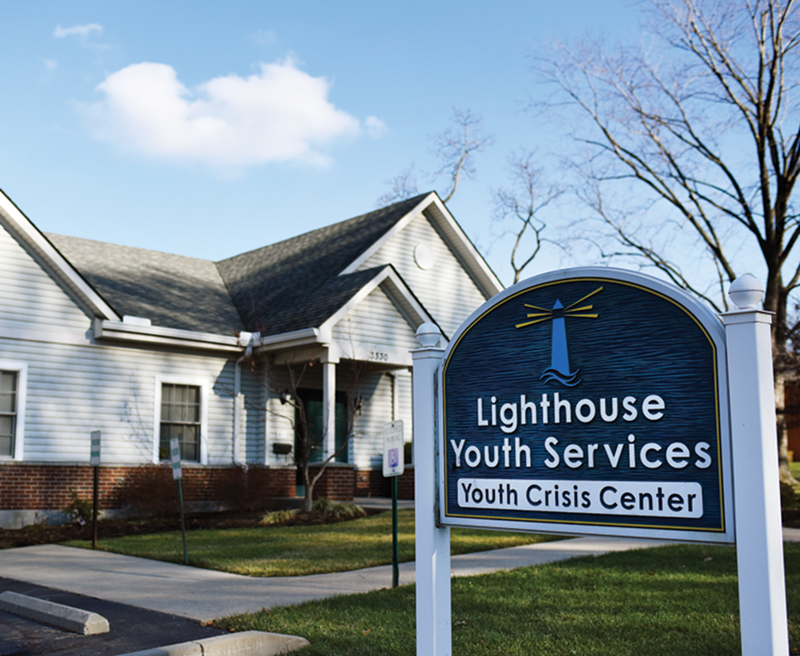
I
n Hamilton County, hundreds of kids are homeless each night. For Lighthouse Youth Services, that’s way too many. The organization strives to identify and help at risk youth before they have nowhere else to turn.
“Our focus is ending youth homelessness in Cincinnati by 2020,” says Lighthouse Director of Communications Sheri Hager. “All the services that Lighthouse offers all lead down that road. We do everything that we can to ensure these youths that need our help and need services have access.”
In order to meet the growing need for outreach in the community, the federal Health Resources and Services Administration (HRSA) recently awarded a grant worth more than $500,000 to the University of Cincinnati School of Social Work to provide master’s-level students with specialized education and training to work with at-risk youth. The training will focus on recognizing and treating kids who are at risk of developing or have already developed significant behavior or health disorders.
Signs for youths being “at risk” may manifest themselves in a number of ways, explains assistant professor Shauna Acquavita, director of the fellowship and the grant’s principal investigator. Behaviors such as repeated absenteeism because of illness or truancy are red flags, she says, that could be related to a family crisis or an undiagnosed mental health disorder. She explains the key is providing intervention early on. In all cases, she says it’s vital to connect at-risk kids with trained professionals.
“It’s really important to make sure these children are treated with the appropriate types of services and therapies that they need,” Acquavita says. “We really pride ourselves on being on top of what are best and safe practices, what has been shown to be successful and what is appropriate for these age groups. So it’s really helpful to be seen by a social worker and know that your child is going to get the appropriate treatment.”
As part of the grant program, students will be mentored by social workers currently treating at-risk youths in agencies throughout Greater Cincinnati. At Clifton’s Lighthouse Youth Crisis Center, director Sidney Taylor says the center provides a safe haven for kids seeking refuge due to personal trauma. This holiday season, Taylor says Lighthouse filled 16 of its 20 available beds with kids in need of shelter. He says this time of year is especially hard on children who have fond memories of a former, happier life.
“It’s just rough — you’ve been having Christmas or Hanukkah or whatever you celebrate and all the sudden there’s a crisis and you’re no longer able to be in that household, and that’s just a difficult thing to deal with,” Taylor says. “Especially with the foster care children and kids that have been separated from their families, so the social workers and case managers work on helping them cope with this time of year.”
At Lighthouse, Hager says the focus is providing some form of stability in these kids’ lives. She explains even volunteers are required to make a long-term commitment of time as opposed to just working with kids for a day or two.
“For the youth that we serve, the last thing that they need is more transition to maybe make a connection with someone and then have them not there the next month,” she says.
But working in social services can be challenging, especially when it comes to providing young people with services, then sending them back into the same environment that caused the need.
Acquavita agrees that working on a daily basis with kids who have endured extreme hardships at such a young age can be heart wrenching. She emphasizes the importance of having students work with mentors in the field in order to see the impact they can have on these children’s lives and recognize their actions can make a difference.
“It can be a stressful population to work with if you don’t have proper training or support,” Acquavita says. “Because some of these cases can be so sad with all these kids have gone through. So we really just want our students to be prepared to be able to do everything they practiced. We’re just really trying to really provide a lot of support in this portion.”
At Lighthouse, support comes in a variety of forms. In addition to providing mental health, substance abuse and family counseling either onsite or through home-based services, Taylor says Lighthouse stations social workers at local schools to keep at-risk kids from going unnoticed. He says schools often provide the sole point of contact for children to get the help they need.
“For instance, Western Hills [High School] is one of the infamous underperforming schools that has a lot of behavioral and disciplinary issues,” Taylor says, “so we have three staff members that are actually stationed there though our school-based and community-based wrap around services.”
But funding for in-school social workers may soon be in jeopardy. On Dec. 9, the Ohio Board of Education voted in a 14-5 decision to abolish the “5 of 8” rule which requires schools to hire five specialized positions from eight categories for every 1,000 students. Social workers made the list of what are now deemed superfluous positions, along with art, music, physical education teachers, librarians, counselors, nurses and visiting teachers.
If the state legislature approves the bill and it passes a final vote by the board in March, cash-strapped schools will be allowed to start eliminating positions.
The decision may leave many kids without the necessary resources they need to get help, Acquavita explains.
“In my opinion, it is a detriment if it isn’t continued as most likely it will impact those schools that serve mostly low-income students,” Acquavita says. “It will make it easier to eliminate those positions to save money where, in reality, those schools will be most in need for social work services.”
In terms of a career choice, Acquavita says people rarely enter the field of social work for the salary, as the position is notoriously low-paying. She says those who follow the path generally have some connection from their past or an innate desire to help others. She has seen former architects and engineers enter the program in order to find a more meaningful career.
“It really takes a special type of person to realize this is what they want to do,” Acquavita says.” The compensation isn’t always what they get monetarily, however emotionally it can be the most rewarding experience people can walk away from and feel truly fulfilled." ©





